One of the most important components of a living cell is fat. This energy concentrate life force the body helps to survive difficult times and adverse environmental conditions. Lipids are divided into two large groups: animal fats and vegetable oils. In addition, they are divided into simple and complex, there are harmful and useful.
General characteristics of fats
Fats are organic compounds responsible for the "reserve fund" of energy in the body. Lipids supply the body with important polyunsaturated fatty acids Omega 3 and Omega 6, arachidonic, linolenic, linoleic acids, which are not produced independently in the body. Major classes of lipids: triglycerides, sterols, and phospholipids.
- 1
Triglycerides. These include saturated and unsaturated fatty acids, made up of glycerol and three carbon chains. Here are examples of foods that contain them in large quantities:
. unsaturated fatty acids- fish oil, oils of nuts, seeds, sunflower, olive, corn, etc. are very important for maintaining the health of the whole organism.
. Saturated fatty acids usually found in animal foods. For example, the meat of various animals, cheese and milk. - 2 Sterols present in almost all tissues of animals and plants. Sterols can be divided into three categories: zoosterols (from animals), phytosterols (from plants), and mycosterols (from fungi). The main sterol of the animal world is cholesterol - the most popular and controversial type of fat for the body. It is found in fatty meat, butter, liver, eggs, and other high-fat foods. As for plant sterols, the most common of them is sitosterol. Also, plants are rich in stigmasterol and brassicasterol. This set of sterols is present in the oil soybeans and in rapeseed oil.
- 3 Phospholipids. Consist of glycerol, phosphoric acid and two carbon chains. Phospholipids are an important part of cell membranes. They provide the plastic properties of cell membranes, while cholesterol provides them with rigidity and stability. Phospholipids are the main source of phosphoric acid necessary for human life.
Foods rich in fats:
The approximate amount is indicated in 100 g of the product
| + 40 more products with high content fat ( the number of grams in 100 g of the product is indicated): | ||||||||||
| Raw smoked brisket | 66 | saury large | 20,9 | Rabbit | 12,9 | Gobies | 8,1 | |||
| Dry yolk | 52,2 | Ham | 20,9 | Beef | 12,4 | chickens | 7,8 | |||
| Pork fat | 49,3 | Herring | 19,5 | beef tongue | 12,1 | horsemeat | 7,0 | |||
| Raw smoked sausage | 45 | Soya | 17.3 | Turkey | 12,0 | Dried porcini mushrooms | 6,8 | |||
| goose liver | 39 | Pork tongue | 16,8 | Chicken egg | 11,5 | Carp | 5,3 | |||
| Egg powder | 37,3 | Mutton | 15,3 | Sturgeon | 10,9 | Pork liver | 3,6 | |||
| bitter chocolate | 35,4 | Salmon | 15,1 | Sturgeon caviar | 10 | Pig's heart | 3,2 | |||
| Goose | 33,3 | Caviar caviar granular | 13,8 | beef brains | 9,5 | Beef liver | 3,1 | |||
| Acne | 30,5 | beef udder | 13,7 | chickens | 8,8 | Pork kidneys | 3,1 | |||
| Lean pork | 27,8 | quail egg | 13,1 | catfish | 8,5 | beef heart | 3,0 | |||
Daily requirement of the body for fats Modern dietology indicates that in order to provide the body with enough energy, the amount of fat in our diet should not be lower than 30%. It is worth considering that 1 gram of fat is equal to 9 kcal. It is recommended to consume 10% saturated fats and 20% unsaturated fats. Permissible daily allowance cholesterol for healthy person should be no higher than 300 mg, and for those suffering from cardiovascular diseases, it is calculated according to the doctor's recommendations.
The need for fat increases:
. Heavy physical work is impossible without sufficient consumption of fatty foods, which keep the body feeling full longer, are high in calories.
. Cold season. Cold forces you to spend additional energy on heating, in addition, adipose tissue perfectly protects the body from hypothermia.
. Pregnancy and lactation. During this period, significant changes occur in the woman's body, and part of the fat is used to feed the baby.
. The lack of fat-soluble vitamins in the body is a signal from the body about the additional need for fat-containing foods, except, of course, for the vitamins themselves.
. Lack of energy. Decreased libido.
Reduced need for fat
. With increased body weight. The amount of fat consumed must be reduced, but not completely eliminated from the diet!
. When living in a hot climate, as well as the onset of the warm season.
. Performing work related to mental work requires carbohydrate foods, but not fatty foods.
Fat digestibility As mentioned above, all fats are divided into vegetable and animal. From medical research data, it became known that vegetable fats digested faster than animals. This is due to the fact that their chemical bonds are less resistant to the effects of gastric juice. Most often, vegetable fats are used for quick receipt energy. Animal fats keep you feeling fuller long time due to their slow absorption. Statistics show that men prefer to consume more animal fats, and women are fans of vegetable fats.
Fats and health Conventionally, nutritionists divide all fats into useful and harmful for the body. Healthy fats- These are polyunsaturated and monounsaturated fatty acids that are found in vegetable oils, as well as in fatty fish and egg yolk (lecithin). As for bad fats, they include fats obtained as a result of cracking oil processing, fats subjected to prolonged heating, as well as fats obtained during the processing of Genetically Modified Organisms (GMOs). Harmful fats are commonly found in margarine, mayonnaise, cooking oil, and foods containing them.
Useful properties of fat and its effect on the body The construction of cell membranes, the synthesis of sex hormones, the absorption of vitamins A, D, E, K - these are just some of the important functions that fat performs in the human body. Fat protects our body from the cold, plays the role of a "safety cushion" for the heart, liver, kidneys during various bodily injuries, and provides energy during a long hunger strike. In addition, fat is essential for the normal functioning of our brain and nervous system.
Interaction with essential elements As you might guess, essential elements are substances and compounds that can interact with each other. For fats, these essential elements are fat-soluble vitamins. Vitamin A is at the top of this list. It is found in foods such as carrots, persimmons, bell peppers, liver, sea buckthorn berries, and egg yolks. Thanks to him, our body has the ability not only to resist all kinds of infections, but also can present itself in at its best. Imagine: healthy skin, luxurious hair, sparkling eyes, and most importantly - Good Mood!!! And all this is the result of using vitamin A.
Now for vitamin D. This vitamin provides an invaluable service to our bone and cartilage system. Previously, when a person did not receive the amount of vitamin D due to him, he fell ill with a disease such as rickets. What a person looked like at this time can be guessed without further description. Vitamin D is found in foods such as olive oil first pressing, fish oil, liver, and it can also be produced by our body, with a sufficient level of insolation. Due to exposure to the sun, a person not only tans, but also stocks up on vitamin D that is so necessary for him. But, as mentioned earlier, these vitamins can be absorbed only in the presence of fat-solvent. Therefore, a lack of fat can lead to exhaustion of the entire body.
Signs of excess fat Now we have to discuss such an important for human health problem like excess fat. Since elements of hypodynamia are inherent in modern society, the result of this phenomenon is excessive deposition of fat in the body, or simply obesity. As a result of this, the following changes occur in the human body:
. Increases blood clotting;
. The processes of formation of hepatic and gallstones are activated;
. Atherosclerosis develops;
. There are degenerative processes in the liver, kidneys and spleen;
. Well, to top off the bouquet, there is an increase in blood pressure, stress on the heart, as well as changes in the bone and cartilage apparatus.
Signs of low fat The lack of fat intake affects not only the fact that a person does not receive the amount of energy he needs for life, but it is even more dangerous for the nervous system. As a result of the restriction of fats, or in violation of the fat balance, a person develops the so-called depletion of the nervous system. This is because the fat-soluble vitamins they eat (such as vitamin A and D) are unable to be absorbed by the body. And the result of this vitamin starvation, in addition to the depletion of the nervous system itself, is also atrophic changes in the eyes, problems with nails, hair, skin, as well as problems with the reproductive system. In addition, with a lack of fat intake, there is a decrease in the body's resistance to all kinds of infections, hormonal imbalance, and early aging of the body.
Factors Affecting Body Fat
. The main factor responsible for the accumulation of fat in the body is hypodynamia. It is followed by the so-called violation of lipid metabolism. This violation, in addition to body fat, can also be the cause of early atherosclerosis. Interesting fact
: residents of Japan, China and the Mediterranean, using in in large numbers greens and seafood do not suffer from this violation.
. The next factor affecting body fat is stress. Because of him, people stop feeling their body, and he arranges for them such a trick with the appearance of excess weight.
. The third factor is hormone. Violation of fat metabolism is often associated with an increase in the level of estrogen in the body.
Cholesterol. Harm and benefit
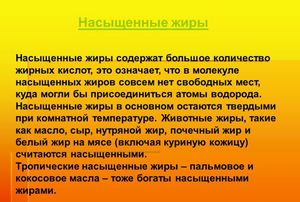
So much has been said and written about him! For some, cholesterol becomes the number one enemy in the fight for health and longevity. However, as evidenced by many medical sources, cholesterol in optimal amounts is not harmful. It is simply necessary for our body. Cholesterol is essential for normal blood clotting. It is responsible for the integrity of the cell membrane of erythrocytes. plays important role in the functioning of the tissues of the brain, liver and nervous system. The body is able to synthesize cholesterol on its own from incoming nutrients. And only a certain amount (about 25%) enters the body with food.
Excessive consumption of fatty foods can lead to the deposition of excess cholesterol on the walls of blood vessels. It leads to development of atherosclerosis, which is the main cause of starvation of all body cells, the access of blood to which was blocked by cholesterol deposits. Therefore, in order to avoid atherosclerosis, it is necessary to reduce fat intake to a reasonable minimum.
Fats in the fight for harmony and beauty
Sometimes, people who want to lose weight completely eliminate fats from their diet. At first, weight loss can please, but then, due to the fact that the body does not receive important vitamins and minerals, unpleasant symptoms may appear:
- 1 irritability,
- 2 dry skin
- 3 fragility of hair and nails.
It turns out that healthy fats play an important role in metabolic rate.
To maintain health, it is also necessary to maintain the ratio between fats. At the same time, Omega-3 and Omega-6 should be in a ratio of 1: 2. And the introduction to the diet vegetable oils, will prevent the formation of early wrinkles, will be an excellent prevention of dry skin and loss of its elasticity.
If there is a lack of body fat, it is necessary to consume such an amount of fat that some of them are stored in reserve. If you need to reduce your weight, it is better to eat fatty foods in the morning. In this case, the released energy will not be put aside "for a rainy day", but will immediately go to its destination.
We have collected the most important points about fat in this illustration and we will be grateful if you share the picture in social network or blog, with a link to this page:
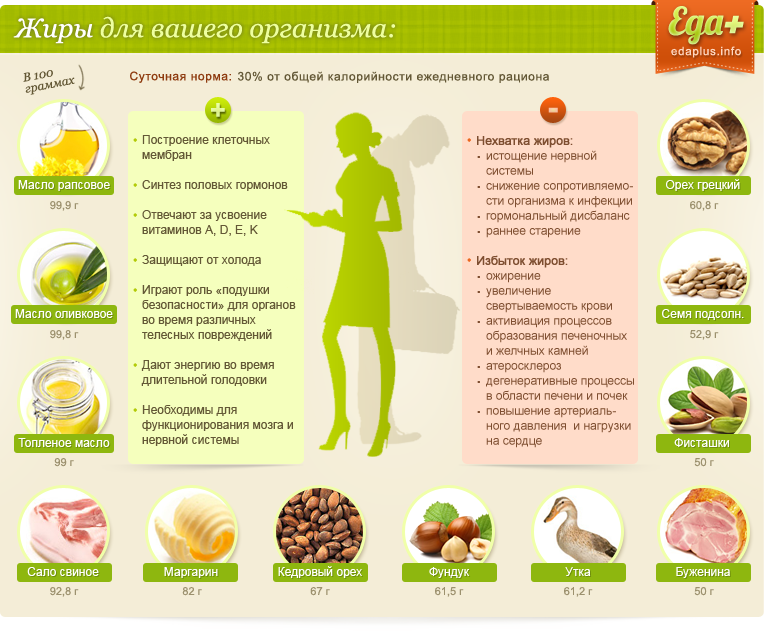
Health
We all know that chocolate, cakes, ice cream and biscuits are the foods who "gift" us the largest number calories. You can deny yourself the consumption of these goodies as often as you like, but this will not save you from the calories that are hidden in other foods that we consume much more often than the above desserts. And if you are serious about preparing your body for the beach season, you might find it helpful to learn more about some of the products that do their "dirty work" invisibly., adding to our body more than one hundred extra calories daily.
1. Mayonnaise.
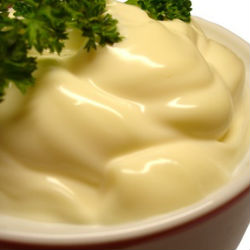 How to limit consumption?
Replace mayonnaise with seasoning low content fat: add a little to the salad soy sauce or balsamic vinegar. Even better - use regular low fat (or low fat) unsweetened yogurt
. You can also add your own sauce with so-called homemade cheese (cheese "cottage"). Stop adding mayonnaise to a salad with chicken or tuna - try adding greens, black pepper and a little tomato instead.
How to limit consumption?
Replace mayonnaise with seasoning low content fat: add a little to the salad soy sauce or balsamic vinegar. Even better - use regular low fat (or low fat) unsweetened yogurt
. You can also add your own sauce with so-called homemade cheese (cheese "cottage"). Stop adding mayonnaise to a salad with chicken or tuna - try adding greens, black pepper and a little tomato instead.
2. Nuts.
 How to limit consumption?
It must be remembered that, in spite of everything, nuts are an essential part of a balanced diet. And even if the fat content in this product is very high, nuts do not contain cholesterol, and fats are the so-called good monounsaturated variety. But if you are concerned about the problem of getting rid of extra pounds, it makes sense to stop eating handfuls of nuts every day. It is also worth choosing nuts with the lowest fat content: for example, the same almonds.
How to limit consumption?
It must be remembered that, in spite of everything, nuts are an essential part of a balanced diet. And even if the fat content in this product is very high, nuts do not contain cholesterol, and fats are the so-called good monounsaturated variety. But if you are concerned about the problem of getting rid of extra pounds, it makes sense to stop eating handfuls of nuts every day. It is also worth choosing nuts with the lowest fat content: for example, the same almonds.
3. Creamer for coffee.
 How to limit consumption?
Even though you hate coffee without creamer, cream should be eliminated from your diet completely, as it is a real storehouse of harmful saturated fats. There is no other way to stop adding cream to coffee! However, it is possible to use skimmed (or low fat) milk. If you don’t have a refrigerator (for example, at work), you can use milk powder - everything is better than adding cream!
How to limit consumption?
Even though you hate coffee without creamer, cream should be eliminated from your diet completely, as it is a real storehouse of harmful saturated fats. There is no other way to stop adding cream to coffee! However, it is possible to use skimmed (or low fat) milk. If you don’t have a refrigerator (for example, at work), you can use milk powder - everything is better than adding cream!
4. Peanut butter.
 How to limit consumption?
Despite the fact that this product is rather typical for American and Western European cuisine, the fashion for peanut butter is beginning to gain momentum in our country as well. And no wonder - peanut butter is an excellent source of monounsaturated fats. However, your waist will not thank you if you abuse this product. However, now you can find analogues of this oil that do not contain sugar. Of course, the amount of fat from this will not decrease, but the calories will decrease. It is recommended to consume no more than four teaspoons of peanut butter per week - and try to eat it only as part of sandwiches.
How to limit consumption?
Despite the fact that this product is rather typical for American and Western European cuisine, the fashion for peanut butter is beginning to gain momentum in our country as well. And no wonder - peanut butter is an excellent source of monounsaturated fats. However, your waist will not thank you if you abuse this product. However, now you can find analogues of this oil that do not contain sugar. Of course, the amount of fat from this will not decrease, but the calories will decrease. It is recommended to consume no more than four teaspoons of peanut butter per week - and try to eat it only as part of sandwiches.
5. Potato chips.
 How to limit consumption?
If you often buy chips, read the information on the product packaging - the amount of fat and calories varies, depending on the manufacturer and brand. However, chips - this is the product in whose justification there is practically nothing to say. It makes sense to replace it regular popcorn- of course, not purchased, but self-cooked. Even saltine crackers contain less fat than crisps, although this is not the best option. AT last resort, choose variations of these products that do not contain trans fats.
How to limit consumption?
If you often buy chips, read the information on the product packaging - the amount of fat and calories varies, depending on the manufacturer and brand. However, chips - this is the product in whose justification there is practically nothing to say. It makes sense to replace it regular popcorn- of course, not purchased, but self-cooked. Even saltine crackers contain less fat than crisps, although this is not the best option. AT last resort, choose variations of these products that do not contain trans fats.
6. Cheeses.
 How to limit consumption?
Whenever possible, always choose low-fat cheeses (like the aforementioned "cottage" cheese, or variations thereof). In more durum varieties cheese, such as cheddar, gouda or parmesan contains much more fat. Try to cut down on foods that contain a lot of cheese. We are talking about products such as pizza, macaroni and cheese, as well as various hamburgers and sandwiches widely offered in fast foods.
How to limit consumption?
Whenever possible, always choose low-fat cheeses (like the aforementioned "cottage" cheese, or variations thereof). In more durum varieties cheese, such as cheddar, gouda or parmesan contains much more fat. Try to cut down on foods that contain a lot of cheese. We are talking about products such as pizza, macaroni and cheese, as well as various hamburgers and sandwiches widely offered in fast foods.
7. Red meat.
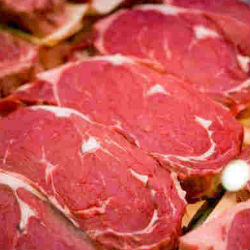 How to limit consumption?
If you compare red meat (pork and beef) with other foods on this list, the percentage of fat does not seem that much. However, the problem is that we eat meat much more often and in much less time. more than, say, the same peanut butter. Buy lean meats (veal, meat of animals obtained by hunting, poultry meat). Eat fish meat more often than red meat. When cooking meat, try to remove as much fat as possible. Avoid consumption of products where fat is clearly visible - salami, homemade sausage and so on.
How to limit consumption?
If you compare red meat (pork and beef) with other foods on this list, the percentage of fat does not seem that much. However, the problem is that we eat meat much more often and in much less time. more than, say, the same peanut butter. Buy lean meats (veal, meat of animals obtained by hunting, poultry meat). Eat fish meat more often than red meat. When cooking meat, try to remove as much fat as possible. Avoid consumption of products where fat is clearly visible - salami, homemade sausage and so on.
8. Pies and flour products.
 How to limit consumption?
Bad news for all those who love to bake and eat pies: this dish is literally teeming with some of the most harmful fats for the body. And don't be fooled by the fact that pies are in eighth place on this list in terms of the amount of fat they contain.- we can eat a pie much more than the same mayonnaise, which comes first. It is worth limiting the consumption of this type of product if you want to lose extra pounds and improve heart health. Replace it with whole grain or rye flour baked goods.
How to limit consumption?
Bad news for all those who love to bake and eat pies: this dish is literally teeming with some of the most harmful fats for the body. And don't be fooled by the fact that pies are in eighth place on this list in terms of the amount of fat they contain.- we can eat a pie much more than the same mayonnaise, which comes first. It is worth limiting the consumption of this type of product if you want to lose extra pounds and improve heart health. Replace it with whole grain or rye flour baked goods.
9. Deep-fried dishes.
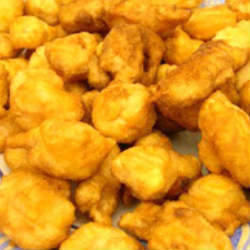 How to limit consumption?
Deep-frying has never been considered a healthy option for any of the dishes. It is better to eat fried donuts or cook sausages on the grill (which is also far from the most useful things!) than to cook deep-fried dishes. We recommend that you also consider any other cooking options - fry, stew, bake - but try to avoid deep-fried foods.
How to limit consumption?
Deep-frying has never been considered a healthy option for any of the dishes. It is better to eat fried donuts or cook sausages on the grill (which is also far from the most useful things!) than to cook deep-fried dishes. We recommend that you also consider any other cooking options - fry, stew, bake - but try to avoid deep-fried foods.
10. Avocado.
 How to limit consumption?
As you know, the so-called monounsaturated fats contained in avocado fruits are also a necessary part of a balanced diet. But excessive consumption of this product will lead to the appearance of extra pounds so don't eat more than one medium serving of this fruit per week. There are lovers of flavoring this product with mayonnaise, we recommend that you abandon this habit so as not to aggravate the situation, but add a little lemon instead - just for flavor!
How to limit consumption?
As you know, the so-called monounsaturated fats contained in avocado fruits are also a necessary part of a balanced diet. But excessive consumption of this product will lead to the appearance of extra pounds so don't eat more than one medium serving of this fruit per week. There are lovers of flavoring this product with mayonnaise, we recommend that you abandon this habit so as not to aggravate the situation, but add a little lemon instead - just for flavor!
For many decades, medical scientists have been talking about saturated fat as a major risk factor for the development of cardiovascular diseases such as atherosclerosis, hypertension, etc. The demonization of saturated fat was based on the theory that they increase the level of low-density lipoprotein (LDL - "bad cholesterol"), which are thought to cause plaque buildup in the arteries and increase the risk of heart attack and stroke.
New evidence suggests that eating foods high in saturated fat may not be directly associated with elevated LDL cholesterol, but a high-fat diet may contribute to obesity, which itself is a risk factor for cardiovascular disease. diseases.
It is important to control your total fat intake and follow a proper diet. The Department of Health recommends that total fat intake should not exceed 35% of our daily consumption calories, and the maximum for saturated fat is 11% of our total daily calorie intake.
Saturated Fat - What's Still True?
- Saturated animal fats are a type of fat found in large quantities in butter and bacon, pies, cakes and cookies, fatty meat, sausages, as well as in fatty dairy products such as cheese, cream and sour cream.
- Most of us eat way too much saturated fat – we meet an average of about 12.6% of our daily calorie needs from this type of fat, which is more than the maximum recommended allowance.
- The recommended amount of total fat (including saturated fat) is the same for both women and men and is no more than 70 grams of fat (20 grams of saturated fat) per day.
New research
Recent studies show that the old evidence that everyone is advised to avoid saturated fats and increase their intake of polyunsaturated fats (such as omega-3 and omega-6) does not ultimately have a decisive effect on health. In a study published in the journal Annals of Internal Medicine, data on more than 600,000 participants were analyzed, resulting in the conclusion that:
“Current evidence does not fully support existing recommendations for the prevention of cardiovascular disease through a significant intake of polyunsaturated fatty acids and low saturated fat intake.
Why you should avoid trans fats
Trans fats, when eaten, have been shown to raise blood cholesterol levels, especially "bad" cholesterol (LDL). Trans fats can also lower your “good” cholesterol (HDL) levels, as well as increase triglycerides, another type of blood fat. All of these effects of trans fats contribute to an increased risk of coronary heart disease (CHD), so their intake should be monitored.
Trans fats are the most harmful type of fat, found in large quantities in fast food and processed food.Saturated fats: good or bad?
When asking the question of whether saturated fat is bad or good for your body, you need to ask yourself one simple question - compared to what?
- Compared to trans fats, saturated fats are healthier.
- Compared to complex carbohydrates such as whole grains, saturated fats are neutral.
- Compared to the refined carbohydrates present in white bread, bakery products, sweets, sugary breakfast cereals and snacks, saturated fats are the best choice.
Refined carbohydrates, more than saturated fats, contribute to the development of cardiovascular disease and other health problems. Simple dietary changes, such as replacing white bread on whole grains, and increasing fruit and vegetable intake will reduce the risk of cardiovascular disease to a greater extent than simply reducing saturated fat intake.
What to look for on food labels
Before the purchase food products carefully read the composition of the product on the packaging label. Look at the column the nutritional value per 100 g "to understand how much fat is contained in the product:
- High Fat= more than 17.5 g fat per 100 g
- Average fat content= 3.1 g - 17.5 g fat per 100 g
- Low Fat= 3.0 g fat or less per 100 g
If the label lists the amount of saturated fat, then the following indicators will come in handy to determine the amount you need:
- High in saturated fat= more than 5 g per 100 g
- Average Saturated Fat= 1.6 - 4.9 g per 100 g
- Low in saturated fat= 1.5 g or less per 100 g
A balanced diet is the key to good health
A healthy lifestyle includes sufficient physical activity, whole foods as the basis of the diet, moderate portion sizes, and a variety of foods. The Mediterranean diet, based on the consumption of fruits, vegetables, whole grains, fish, and foods made from vegetables and vegetable oils, is associated with a lower risk of heart attacks and cardiovascular disease. A diet rich in whole foods is often more effective in preventing cardiovascular disease than restrictive diets low in fat and cholesterol.
How do you feel about the latest evidence regarding saturated fats? We'd love to hear what you think about this... The comment form is below.
For many decades, losing weight was afraid to eat foods with a high percentage of fat. But fats are also different!
Some fats (trans fats) increase bad cholesterol and cause diabetes. Others (unsaturated fats) help to strengthenimmune system and prevention of cardiovascularvascular diseases.
In addition, healthy fats are good for weight loss. Since they are involved in the secretion of hormones and contribute to rapid saturation.
The first benefits of exposure to the right fats can be seen in improving skin color and normalizing bowel function.
And when consumed regularly, they help reduce chronic pain and inflammation, as most foods that contain healthy fats are rich in powerful anti-inflammatory agents (omega-3s).
List of foods with healthy fats for weight loss
Fish fat
Eating this fat is important not only for weight loss, but for overall health. Recently, studies by an Australian professor were completed, which showed that the use of fish oil increases the effectiveness of training aimed at weight loss.
You can find this type of fat in large quantities in the liver of Atlantic cod, as well as in such types of fish as mackerel and halibut, sturgeon and salmon.
Salo
Many mistakenly believe that this product is fatty and not good for the body. Yes, lard is only made up of fats, but these are healthy fats that help you lose weight.
They contribute to the active burning of excess calories. Although, of course, you should not abuse this product: a small piece per day is enough.
Meat
Most grams of healthy fat can be found in pig meat. So, for 100 grams of such meat, there are 2 grams of fat. Of course, it's not about fat. pork cutlet, namely the tenderloin of a young calf, properly steamed or in water.
Incidentally, the use a small amount piglet meat favorably affects the work of the cardiovascular system. It should be noted that steam pig is not only a source of monounsaturated fats, but also potassium and iron.
Nutritionists are inclined to believe that pig meat is healthier than white poultry meat. From beneficial species meat, you can also pay attention to the lamb (young lamb). One hundred grams of the product contains 3.5 grams of fat.
nuts
Anyone who counts calories knows that nuts are high in calories. But you can eat a handful a day. The product improves the work of the heart and blood vessels, suppresses the feeling of hunger.
Each type of nuts is useful in moderation, all contain healthy fatty acids. So, 10 grams of pistachios contain 2 grams of healthy fat. In the same quantity walnuts useful fat will be 0.7 grams, and almonds - 3 grams, in hazelnuts 4 grams, in 100 grams of pine nuts - 1.5 grams.
If your goal is to lose weight, it is better to choose pine nuts, which contain an acid that suppresses hunger. Due to the content of copper, hazelnuts have a beneficial effect on the absorption of iron by the body, pistachios reduce the level of bad cholesterol, and almonds help rejuvenate the body.
Oil
All nutritionists agree that the most healthy oil is the olive one. It saves the most useful properties, is an excellent antioxidant, has a great effect on the functioning of the body as a whole. A tablespoon of olive oil contains 9 grams of healthy fats.
Another useful one is linseed oil. But it has a special spicy aftertaste that not everyone likes. It is important to buy only cold-pressed oil, which retains unsaturated fatty acids that bring benefits.
Avocado
10 grams of tender avocado pulp contains 1 gram of healthy fat. Moreover, the fruit itself is 75% composed of vegetable fats. All fats are useful and necessary for a person for health and beauty.
Plus, the fruit pulp contains many vitamins and minerals. It is only important to eat avocado pulp exclusively in its raw form. If the product is thermally processed, then it will no longer be so useful.
seeds
Many healthy fats can be found in soybeans or flax seeds. But it is important to use these products in strictly limited quantities.
bitter chocolate
Oddly enough, but the real one is a product to which nutritionists are more than condescending. It helps to lose weight and contains healthy fats, but it is important that the product is 70% or more cocoa.
100 grams of dark chocolate contains 32 grams of healthy fat (if the chocolate contains nuts, this figure will be higher).
hard cheese
In addition to high-quality cheese containing healthy fats, it also contains calcium and vitamins. The only thing to take into account is the fact that when losing weight, you can eat only those cheeses whose fat content does not exceed 40%. For example, consider mozzarella.
And a few more tips:
- No matter how healthy unsaturated fats are considered, their consumption also needs to be controlled. Daily rate- 1 gram per 1 kg of your weight.
- The less processed the product is, the more useful it is. Prioritize seeds, nuts, vegetables, and then fish, butter, cheese, and other cooked foods.
- Variety, variety and more variety! Each product contains a different ratio of fatty acids and its own supply of useful properties.
Include healthy fats from the right sources in your diet and those extra pounds will melt like snow in the spring.
August 10, 2014 4052
The popularity of a healthy lifestyle is steadily growing.
More and more people give up bad habits and prefer to go in for sports, be more attentive to their diet.
Unfortunately, not everyone can afford to turn to a professional nutritionist to create an individual nutrition program.
And searches for information on the Internet often do not result in answers, but only an increase in the number of questions.
One such controversial topic is the problem of fat consumption.
This is especially true among women, because for many of them fats are associated exclusively with a threat to the figure, and the word “cholesterol” alone can cause panic.
Therefore, after analyzing the available information on this topic and armed with the advice of experts, we will try to figure out whether it is worth introducing fats into your diet.
To begin with, it should be noted that fatty acids, of which fats are predominantly composed, can be divided into three categories:
- saturated;
- monounsaturated;
- polyunsaturated.
What is the difference between them, and which of them should be eaten and which are recommended to be avoided, we will now consider in more detail.
Hydrogenated fats

A little chemistry.
Saturated (marginal) fats are monobasic fatty acids, i.e. have a simple single carbon bond, there are no double bonds between carbon atoms in their structure.
The molecules of such fats are saturated with hydrogen.
The most common saturated fatty acids are:
- Stearic (a lot of it in lamb fat and vegetable oils)
- Palmitic (found in large quantities in palm oil, in lard).
- Also to this species acids include margaric, lauric, myristic and others.
Now for some biology.
Once in the blood, saturated fats merge, forming spherical compounds that are easily deposited in adipose tissue.
This fact often gives rise to various myths about the dangers of limiting fats and the need for their complete elimination from the diet.
For example, it is a widely held myth that eating saturated fat leads to clogged arteries and even heart attacks.
Numerous studies have shown that there is no significant association between the consumption of foods containing saturated fats and diseases of the cardiovascular system.
Health problems arise under the influence of a combination of lifestyle factors, so you should not be so afraid of limiting fats.
The myth that saturated fatty acids cause insulin resistance should also be disproven.
Indeed, the use of palmitic acid can lead to such consequences, however, it must be borne in mind that no product contains exclusively this type of acid.
Both meat and eggs, which are often exposed as enemies of our health, contain other types of fatty acids that neutralize the negative effects of palmitic acid.
And finally, the most popular myth is that eating saturated fat leads to obesity.
Of course, their unsystematic and unlimited consumption will have Negative consequences for the figure, just like the excess intake of proteins and carbohydrates.
But with the right approach, a diet enriched with saturated fatty acids will benefit not only health, but also the figure.
On the benefits of saturated fats:
- are a source of energy for the body;
- take an active part in the process of synthesizing hormones, building cell membranes;
- contribute to the successful absorption of vitamins and minerals;
- in female body contribute to the normalization of the menstrual cycle, have a beneficial effect on the reproductive system.
Thus, people who monitor their health and pay attention to their figure should include foods containing saturated fats in their diet.
On average, the rate of consumption of this type of fat is 15-20 grams per day.
On a note
List of foods that contain saturated fatty acids:
- dairy;
- meat;
- oil (both butter and palm, coconut, cocoa butter);
- eggs;
- chocolate.
Unsaturated fatty acids
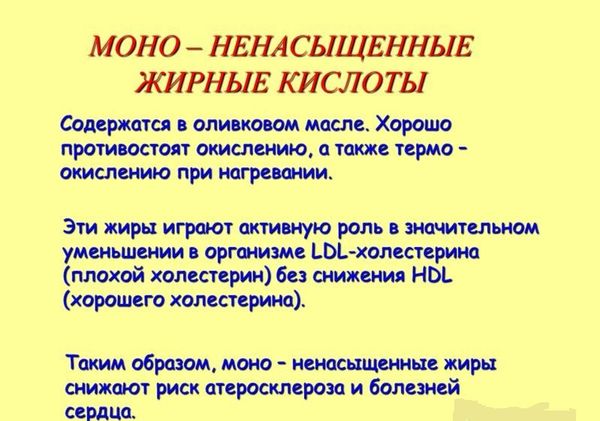
A little chemistry.
The structure of fatty acids, which make up unsaturated fats, is characterized by the presence of a double carbon bond between neighboring atoms.
This ensures their ability to oxidize and high biological activity.
With normal room temperature are in a liquid state, a decrease in temperature causes solidification of monounsaturated fats, while polyunsaturated fats remain liquid at any temperature.
A bit of biology.
The human body does not produce unsaturated fats on its own, so it must be obtained from food.
Unlike saturated fatty acids, unsaturated fat molecules do not combine when they enter the bloodstream, so they pass through the arteries unhindered.
As already noted, unsaturated fats are divided into two types: monounsaturated and polyunsaturated.
What are the benefits of unsaturated fatty acids?

Monounsaturated fatty acids:
- contribute to the maintenance of normal blood cholesterol levels, reducing the "bad" (LDL) and increasing the proportion of "good" (HDL);
- have an anti-inflammatory effect;
- have a beneficial effect on the functioning of the heart.
Polyunsaturated fatty acids:
- maintain immunity at a high level;
- improve brain function;
- serve to prevent the occurrence of cancer cells;
- help reduce blood clotting, preventing the formation of blood clots;
- increase the smoothness and hydration of the skin.
It should be noted that the most useful for the human body are such polyunsaturated acids, like linoleic and alpha-linolenic, better known as omega-6 and omega-3.
It is important to achieve a balanced intake of omega-3 and omega-6, not allowing the substitution of one type of acid for another.
On a note
List of foods that contain monounsaturated fatty acids:
- nuts (almonds, peanuts, cashews);
- avocado;
- vegetable oils (olive, walnut, sesame, sunflower).
Products containing polyunsaturated fatty acids:
- salmon;
- walnuts;
- vegetable oils (soybean, corn);
- sesame seeds, sunflower seeds;
General rules for eating fats:
- in the daily diet, approximately 1/3 should be fat;
- the optimal amount of fat is 1 gram for every kilogram of your weight;
- increase the amount of fat during intense physical activity(including during hard work), as well as while in cold climatic conditions.
Thus, we can say that it is impossible to divide fats into “bad” and “good”, all of them are necessary to ensure the normal functioning of the body.
You just have to be careful when planning your diet. Take advantage of our tips and stay healthy.
Videos dessert
We bring to your attention a video about saturated fats. Omega fats, and are they needed?


